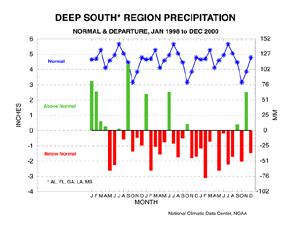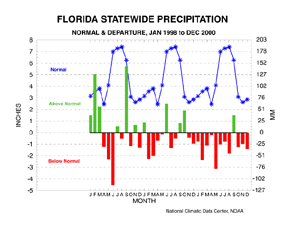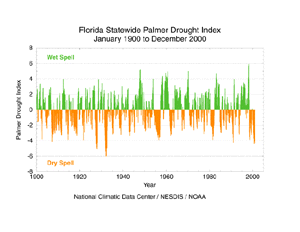Contents Of This Report:

 National Overview
National Overview
| On the national scale, drought affected just under ten percent of the contiguous United States as of the end of December 2000, reflecting little change from the overall conditions of last month (see graph below left). At its August peak of 36% coverage, the 2000 drought was as extensive as the major droughts of the last 40 years, but not as large as the "dust bowl" droughts of the 1930's and 1950's (see graph below right).
A large part of the western U.S. experienced the second dry month in a row. While short-term conditions improved in the southern Plains and Deep South, long-term conditions remained quite dry in this region. Although different parts of the U.S. have experienced unusually wet conditions during the last 12 months, there continues to be little change in the overall national wetness picture. The percentage of the nation severely wet has remained near 5% during this period (see graph below left). |
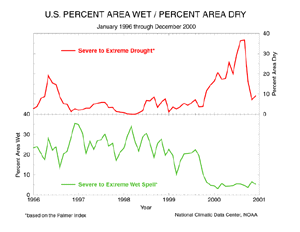 larger image |
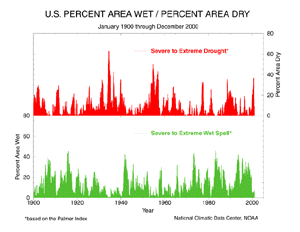 larger image |

 Palmer Drought Indices
Palmer Drought Indices
| The Palmer Z Index shows how monthly moisture conditions depart from normal (short-term drought and wetness). December 2000 was severely dry along the west coast and in parts of the Pacific Northwest, Southwest, and Southeast. The animated maps to the right show the geographical pattern of the moisture anomalies for the last 12 months. On these maps, the red shading denotes dry conditions while the green shading indicates wet conditions. | 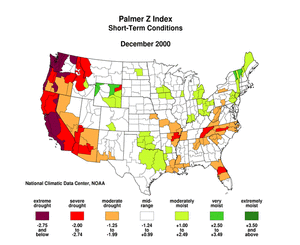 larger animated image |
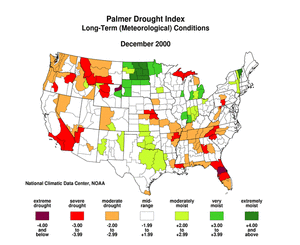 larger animated image |
The Palmer Drought Index maps show long-term (cumulative) meteorological drought and wet conditions. Recent rains brought drought relief to some areas of the Deep South. However, long-term meteorological drought persisted across other parts of the Deep South, southern Appalachians, northern Rockies, central Plains, and northern Great Lakes, and was developing across parts of the Far West. The animated maps show how the geographical pattern of the long-term (meteorological) moisture conditions has changed over the last 12 months. On these maps, the red shading denotes drought conditions while the green shading indicates wet conditions. |
| The Palmer Hydrological Drought Index maps show long-term (cumulative) hydrological drought and wet conditions, which more accurately reflect groundwater conditions, reservoir levels, etc. The PHDI indicates that hydrological drought persisted through the end of December across most of the Southeast and parts of the West, central Plains, and northern Great Lakes. The animated maps to the right show the geographical pattern of the long-term (hydrological) moisture anomalies for the last 12 months. On these maps, the red shading denotes dry conditions while the green shading indicates wet conditions. | 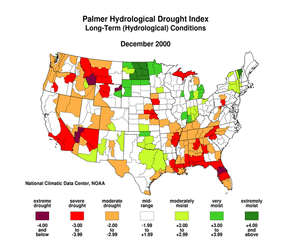 larger animated image |

 Regional Drought Watch:
Regional Drought Watch:
 Standardized Precipitation Index
Standardized Precipitation Index
| The Standardized Precipitation Index (SPI) is another way of measuring drought. The SPI is an index based on the probability of recording a given amount of precipitation, and the probabilities are standardized so that an index of zero indicates the median precipitation amount (half of the historical precipitation amounts are below the median, and half are above the median). The index is negative for drought, and positive for wet conditions. As the dry or wet conditions become more severe, the index becomes more negative or positive. While the Palmer Drought Index is a water balance index that considers water supply (precipitation), demand (evapotranspiration) and loss (runoff), the SPI is a probability index that considers only precipitation.
The seven maps below show the December 2000 spatial patterns of SPI for seven different periods ranging from one month (short-term conditions) to 24 months (long-term conditions). When taken together, they give a combined geographical and temporal picture of the severity of precipitation anomalies. The maps illustrate, for example:
|
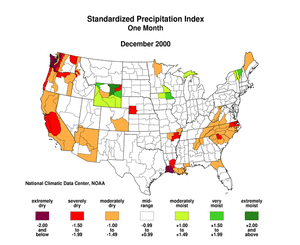 larger image |
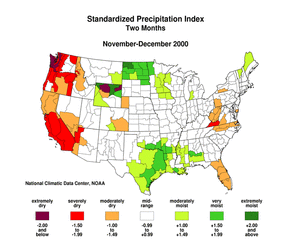 larger image |
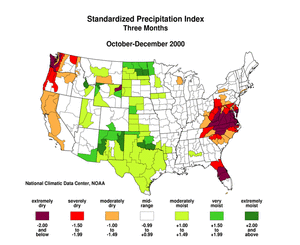 larger image |
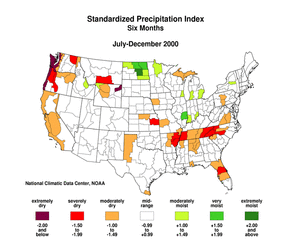 larger image |
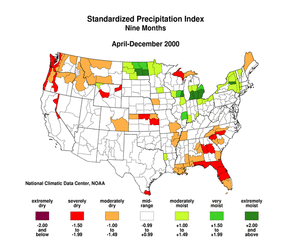 larger image |
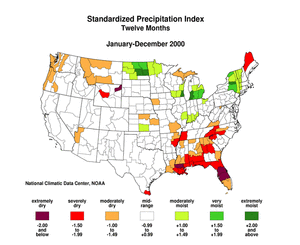 larger image |
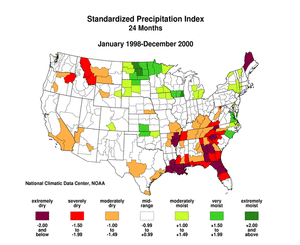 larger image |
 Deep South Drought
Deep South Drought
| Dry conditions returned to much of the U.S. Deep South (AL, FL, GA, LA, MS) this month, with December 2000 ranking as the 24th driest December in the region's aggregate record. Only two of the last 14 months had regionwide precipitation above normal (see graph below), giving 2000 a rank of third driest year on record (see table to right). Across the Southeast region, 2000 ranked as the sixth driest year on record. Significant precipitation deficits remained on the 12-month to 24-month time scales. |
|
| Much of Florida experienced another dry month in December. Only one month out of the last 14 had above-normal precipitation (see graph to right), giving the state the driest year on record in 2000 (see graph below left). Hydrological impacts continued to worsen as record low streamflow, lake and groundwater levels were reported, and the risk of wildfires continued to be a major concern. In response to the worst drought conditions since the 1930's (see graph below right), emergency mandatory water-use restrictions have been imposed by water managers in many Florida communities. |
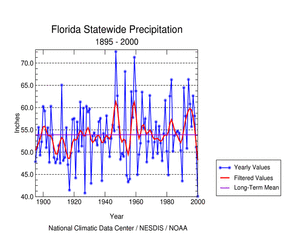 larger image |
 Western Dryness
Western Dryness
| In 2000, the dryness of November continued through December in two western U.S. regions. The West region had the fifth driest, and the Northwest region the eighth driest, December on record. When the dryness of the last two months is combined, both regions rank as having the fourth driest November-December. |
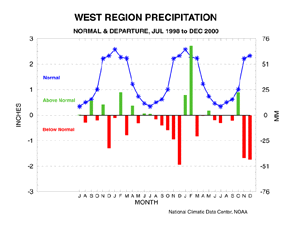 larger image |
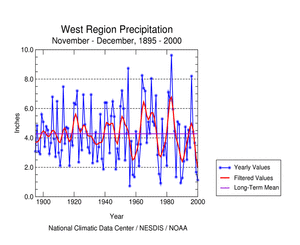 larger image |
| The dry start to the water year in the western U.S. has resulted in a much below average snowpack in many of the river basins. As noted by the Drought Monitor, however, it is important to keep in mind that there is a long way to go in the snowpack season and the dry weather pattern can break down and change quickly. In addition, the water systems here are meant to buffer against a year or more of dryness and reservoir levels were generally in good shape. Impacts were being seen however, by early January 2001 along the coastal and valley areas of central and south-central California where the abnormally dry conditions were causing high concerns for wildfires. The lack of precipitation was also having an effect on non-irrigated agricultural activities such as winter pasture conditions for livestock and for planting wheat. |
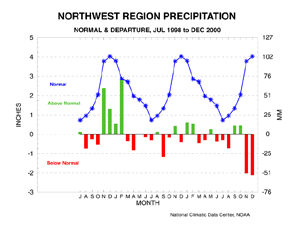 larger image |
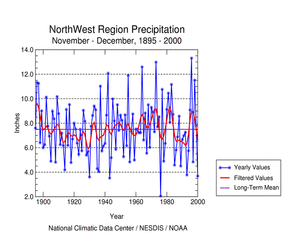 |

 Additional Contacts:
Additional Contacts:
| Damage due to the drought has been summarized by NOAA and the Office
of Global Programs in the Climatological Impacts section of the Climate
Information Project. Crop impact information can be found at the USDA NASS (National Agricultural Statistics Service) and Weekly Weather and Crop Bulletin pages. Drought
statements by local National Weather Service Offices can be found at the NWS Hydrologic Information Center. Drought
threat assessments and other information can be found at NOAA's Drought Information Center. Additional drought
information can be found at the National Drought Mitigation
Center, the USDA's National Agricultural Library,
and the NOAA Paleoclimatology Program. The following states have set up web pages detailing their drought emergencies:
New Mexico - North Carolina - Oklahoma - South Carolina - Texas For additional information on the 2000 wildfire season please see the National Interagency Fire Center web site or the U.S. Forest Service Fire and Aviation web site. Additional climate monitoring graphics can be found at the Climate Prediction Center's monitoring pages: |
 NOAA's National Centers for Environmental Information
NOAA's National Centers for Environmental Information
